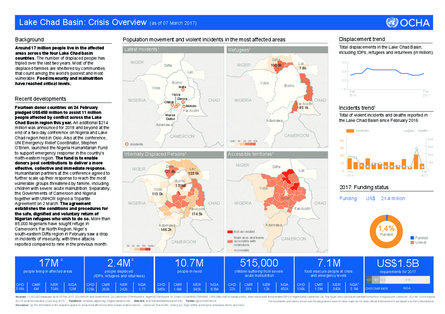
Background Recent developments Around 17 million people live in the affected areas across the four Lake Chad basin countries. The number of displaced people has tripled over the last two years. Most of the displaced families are sheltered by communities that count among the world’s poorest and most vulnerable. Food insecurity and malnutrition have reached critical levels. Fourteen donor countries on 24 February pledged US$458 million to assist 11 million people affected by conflict across the Lake Chad Basin region this year. An additional $214 million was announced for 2018 and beyond at the end of a two-day conference on Nigeria and Lake Chad region held in Oslo. Also at the conference, UN Emergency Relief Coordinator, Stephen O’Brien, launched the Nigeria Humanitarian Fund to support emergency response in the country’s north-eastern region. The fund is to enable donors pool contributions to deliver a more effective, collective and immediate response. Humanitarian partners at the conference agreed to further scale up their response to reach the most vulnerable groups threatened by famine, including children with severe acute malnutrition. Separately, the Governments of Cameroon and Nigeria together with UNHCR signed a Tripartite Agreement on 2 March. The agreement establishes the conditions and procedures for the safe, dignified and voluntary return of Nigerian refugees who wish to do so. More than 85,000 Nigerians have sought refuge in Cameroon’s Far North Region. Niger’s south-eastern Diffa region in February saw a drop in incidents of insecurity, with three attacks reported compared to nine in the previous month.